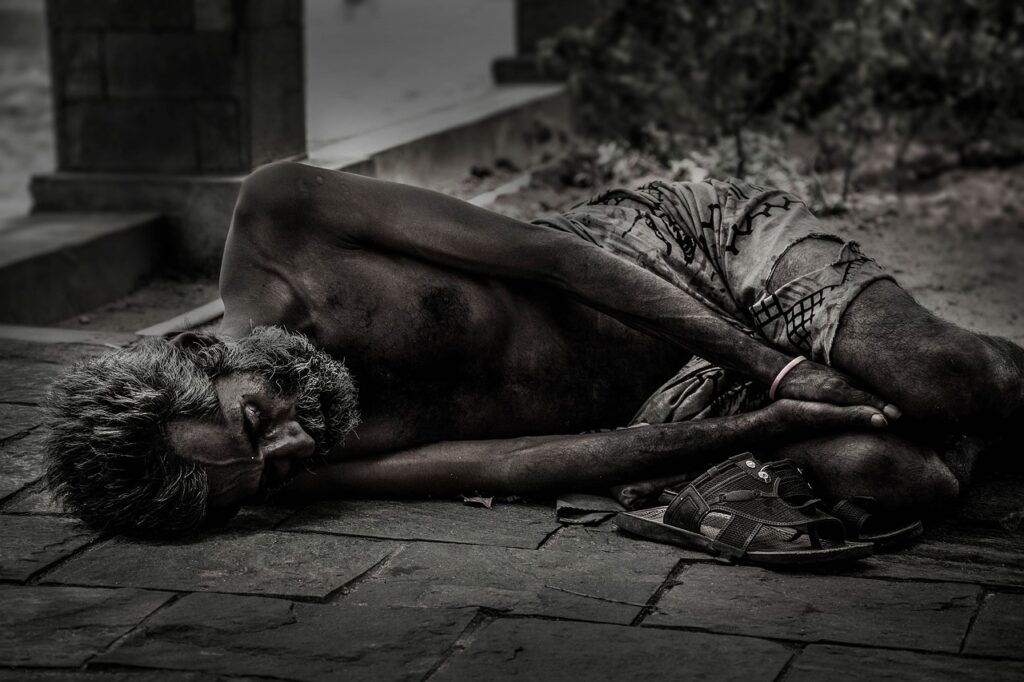SUMMARY
- The magic of capitalism & Just-in-time supply chains
- The ugly consequences of lockdowns
- A global food shortage and a mass starvation event in the making
- The great fertilizer shortage and it’s repercussions
- This time it’s different?
- Government making things worse…like always.
- The climate change propaganda
- How we plan to trade and invest to protect ourselves
I have been talking about a potential food crisis and a mass starvation event for quite some time now. I first tweeted about it in April 2020 and food prices have inflated massively since then. Also compiled a Reddit post about the looming crisis a couple of months ago and now I’ve finally decided to pen down a detailed article on the coming food shortage.
Social media has destroyed the attention span of most people. Many are addicted to the quick hits of dopamine these platforms provide and they can’t focus on something for too long. I hate to be the bearer of bad news, but if you fall in this category, then you’ll have to put in some efforts into reading this article. Well, as they say nothing worth having comes easy.
The Magic of Capitalism
We live in a world where it has become really easy for people to get stuff. You want water, you turn on the tap and there’s water. You see something you like, you just order it from Amazon and *poof* it’s delivered to your doorstep like magic. In fact, for most people, this beautiful aspect of capitalism is like magic as they don’t know or care about the process of making and delivering the stuff to their doorstep.
Now, the process of manufacturing something and delivering it to you is complicated. It involves hundreds or even thousands of people. And over the years, the supply chain has traded robustness (ability to withstand a crisis) for efficiency (higher profits, quick deliveries etc.). This is also known as “Just-in-time” inventory management system.

The purpose of JIT is to keep the lowest amount of inventory possible (to reduce storage costs & boost profits) and offer the best service possible. But the problem is that the JIT system assumes there isn’t ever going to be a crisis. And when lockdowns happened, they exposed the fragility of this system.
Lockdowns have Consequences
A lot of people think that economy is like a switch that you can turn on & off whenever you like without any consequences. But that’s now how it works, you see. Lockdowns have consequences.
Ugly consequences.
The reason why communism has failed every time is because economy is a big complex machine that can’t be centrally planned. If you change one thing at one place, there will be some kind of impact at some other place.
To give you an example, just the other day I was talking to my friend who is a farmer. There were a few people in his village who wanted to plant watermelon in the coming season. However, due to the fear mongering around the mild Omicron variant (or as we like to call it “scariant”), the farmers ditched their plans.
They were worried about another lockdown that would make it impossible for them to find the required labor to plant, grow and transport their produce to sell it.
You may think they’re just some farmers from a small village and it won’t make much difference. But the thing is, hundreds of millions of people are now making decisions based on the possibility of another lockdown. People will not buy trucks or open new factories if they fear a lockdown can cripple their business and cash flows.
And for a supply chain that’s on Just-In-Time inventory, these decisions will lead to bottlenecks and a supply chain crisis, the likes of which we saw in 2021. But it’s just the beginning. Things are going to get extremely ugly in this decade. And I do not say this to fear monger. I actually believe that this going to be an extremely difficult decade for everyone (apart from billionaires and politicians of course).
As a business owner, it can get frustrating seeing the politicians in the country organize rallies for election while you have to close down your business and stay inside your home. But unless there are widespread protests against the lockdowns, there’s not much you can do apart from planning for the future, like the farmers in my friend’s village.
Majority of people who have the privilege to work from home on a laptop usually support lockdowns because they think it doesn’t affect them and they just want to feel safe. But it has, in the form of massive inflation.
For people who are NOT living paycheck to paycheck or earning a daily wage, inflation running hotter-than-expected isn’t really a big deal. But for people who live below poverty line or have no savings, inflation, especially in food, it is a matter of life and death.
Food Shortage and Mass Starvation
Now we don’t take any pleasure in predicting this, but judging by what’s happening worldwide, it seems to us that the possibility of a worldwide food shortage is quite high.
For people with corporate jobs, food shortage just means that they will have to pay some more money for their daal & rotis. They won’t starve to death like the poor people.
Almost 7,000 people die every day in India because of hunger. That’s 25 lakhs per year, meaning since the pandemic and lockdowns have started, over 10 times more people have died from hunger than from COVID. And that’s based on the assumption that the 7,000 per day figure didn’t increase further because of lockdowns (which is unlikely).
Fertilizer Prices to the Moon
So why are we predicting a food shortage?
I’ll try to keep things simple. The current population of the world is nearly 8 billion. And as per data, we are only able to feed half of the near-8 billion people only because of fertilizers. Fertilizers help farmers improve the yield of their produce. They’re able to grow more food and which is why we have enough to feed 8 billion people.
First, the disruption of the supply chain has affected production and procurement of fertilizers. The supply chains are also facing issues due to vaccine mandates in western countries. Many people who are key to the supply chain (like truckers) are reluctant to take the vaccine which is exacerbating the issue.
Second, the process of making fertilizer is energy intensive. You need Natural Gas for the production of ammonia which is required to make fertilizers. You also need energy to make phosphate, which is another chemical used in the manufacturing of fertilizers.
If you’re a premium member of The Logical Traders, you would know that we’ve went through a small drawdown in the fourth quarter of 2021, but our long Natural Gas trades yielded us a nice profit. We take asymmetric trades with high profit potential and our Natural Gas trade unfortunately didn’t work because the U.S. had a milder-than-expected winter. (Nat Gas is used for heating homes)
If winters were near or colder than the historic average, then our trades in Nat Gas could’ve yielded a 100%+ return. Don’t believe me? Check out what happened to Nat Gas prices in Europe.
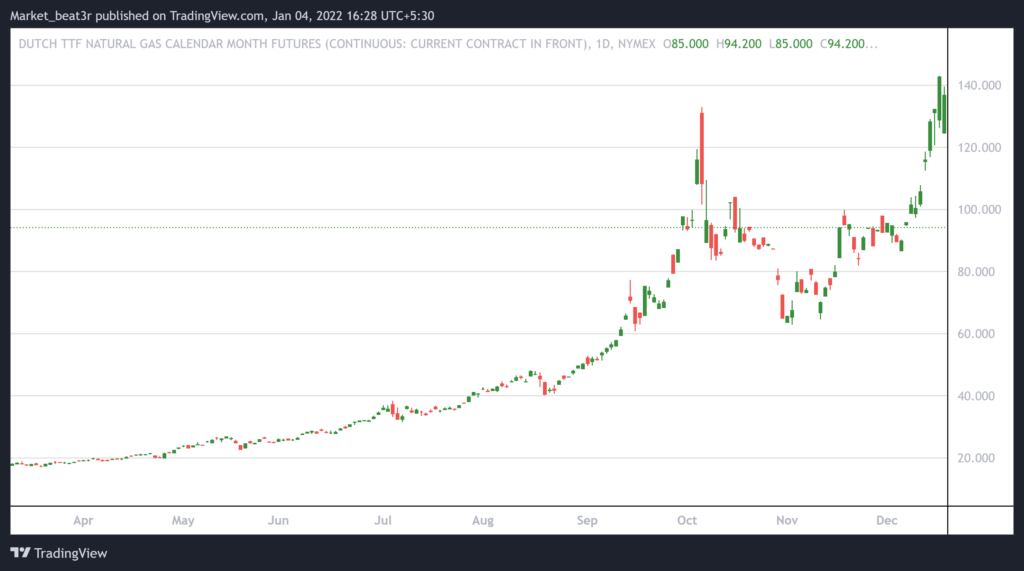
We can’t predict the weather. We can only take trades with huge profit potential. Sometimes they work, sometimes they don’t. That’s how this business works.
Now, Europe relies on Russia for Nat Gas & Russia wanted approval of its Nordstream 2 pipeline to Germany in order to alleviate the Nat Gas crisis. Many countries in the EU have basically shot themselves in the foot by pushing for the “green energy revolution”. As a result, many people have been forced to choose between heating their homes in bone-chilling winters and feeding their families.
I’ll leave the details for another article. For now, just check the electricity prices across the “green” European countries. Hint: Poland is not green. (and we predict it will leave the EU in the coming years)
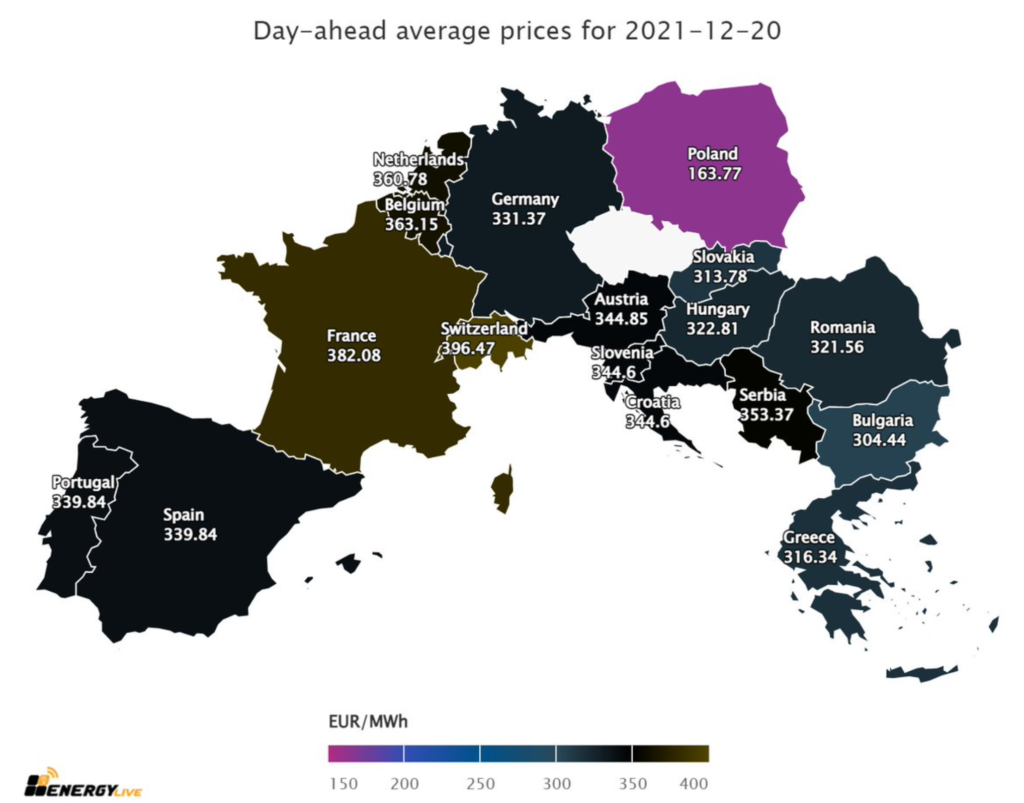
Before 2021, €100 per Megawatt hour was considered expensive. As of now, Europeans are paying over €350 on average. Consequently, a lot of companies have had to shut down production because it’s not profitable for them to continue operating when costs are this high. And of course, that includes fertilizer companies too.
Since Nat Gas went parabolic in Europe, so has ammonia, and consequently fertilizers too. Food prices closely follow fertilizer prices so you can guess what’s coming next.


No natural gas = no nitrogen fertilizer for crops
No natural gas = no CO2 (as a byproduct of fertilizer manufacturing)
No natural gas = no packaging for processed foods
No natural gas = no meat and poultry production
No natural gas = no fizz in beer or sodas… and, you guessed it, way higher food prices.
And to make matters worse, China announced that it is going to ban phosphate exports. China accounts for about 30% of the world’s phosphate trade. So the export ban is bad news. Extremely bad news.
“This Time it’s Different?”
Supply side issues USUALLY don’t last long. The cure for high prices is high prices. This is another beautiful aspect of capitalism. Rising prices incentivize new producers to come to the market and sell their product for a big profit. But as they start producing, the supply increases which in turn brings the prices back down. Balance gets restored.
This self-correcting mechanism of capitalism is what makes the entire commodities segment cyclical.
BUT
This time we’ve had lockdowns and mandates globally. So this mechanism isn’t working efficiently. People are worried about lockdowns and supply chains are wrecked. So why would they want to start a new business now?
Sir John Templeton once said, when someone utters the words “this time it’s different” in investing or trading, you should turn around and run the other way. Usually, it’s a sentiment indicator and a sign of market reversing. But due to lockdowns, it looks like this time is indeed different.
Protectionism Won’t Save the Day
Governments across the world become protectionists when there are shortages. China is being protectionist by banning exports and the Indian government is doing it by offering subsidies on fertilizers. But the thing is, when governments interfere with the free markets, more often than not, they make things worse.
By offering subsidies, government is artificially boosting demand for fertilizer. But the prices are rising because there’s a worldwide shortage and subsidies can’t make more fertilizer appear. And India imports a lot of the fertilizer that’s required for farming. So you, as a taxpayer, end up footing the bill for these subsidies and you also have to pay higher costs for food. Double whammy.
Sounds unfair, right?
Well, guess what?
The politicians don’t care about you. They care about getting reelected. And pissing off farmers is not going to get them reelected. So, instead they’ll do what they have been doing for decades, squeeze the taxpayers just a “little bit” more.
And the end result? Nothing really changes.


You know what they say about such speculation,
“Never believe a rumor until it has been officially denied.”
So last year when Haryana’s government was saying “there’s no shortage of fertilizer in the state”, the Haryana police was beating the people who had lined up to buy fertilizer from the…
*drum rolls*
Police Station.
Imagine that. There’s no shortage but they were selling it from police station under the strict watch of police personnel.
And it’s just not an India thing, it’s a worldwide phenomenon.
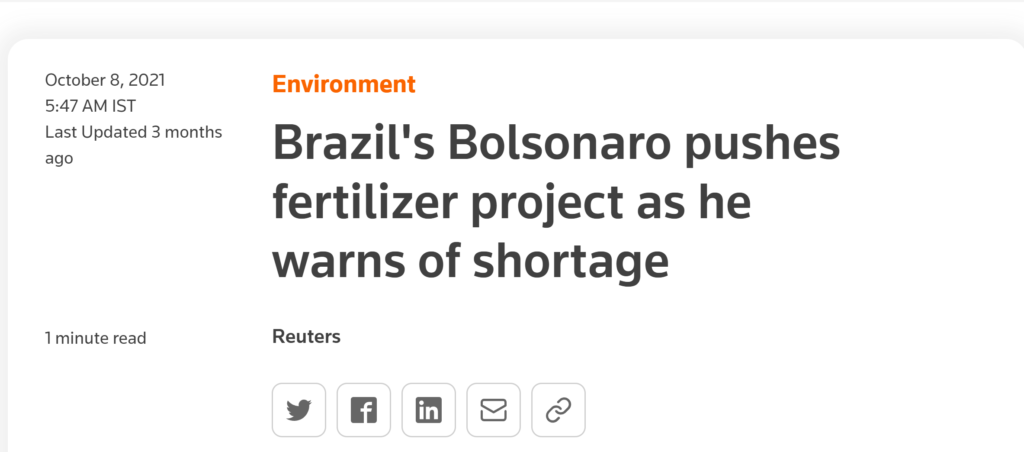
Psst, in case you didn’t, know Brazil is the fourth largest food producer in the world.
Here are a few more things that politicians do when prices spiral out of control:
- Blame greedy corporations
- Blame other politicians or countries
- Ban hoarding
- Ban speculation (ban short selling in case of falling stock markets)
- Price controls
- Raise interest rates
- Rationing
And guess what our government did last month?

The chances of this ban making a dent on inflation are quite low. In fact, this just shows that inflation is becoming a grave concern and is likely to get worse in the future.
What’s That Got to do with Climate Change?
When it comes to politics, most people strongly support a leader or a political party. But we believe that the world is divided between just two classes, the ruling class and the working class. The ruling class consists of the politicians, bureaucrats, and the billionaires who can influence them with money.
The working class, on other hand consists of all the other people. So while you may passionately support a politician, the politician only cares about winning reelected and would throw you under the bus without a second thought if it increased the chances of his/her reelection.

Apart from getting reelected, politicians also love blaming “others” for their failures. That’s the nature of politics. I will have to write another detailed article to explain to the ruling class is planning to greatly reduce your standards of living and take away your privacy & freedoms. So I won’t get into much detail right now.
To keep things simple, we believe climate change is the next scary boogeyman that will be used to scare people. The ruling class will blame anything and everything on climate change. With the advent of social media, it has become fairly easy for the ruling class to shape the opinion of the working class. Let me give you a few examples.
If something is “trending”, it shows up on your Twitter or Facebook feed. Now the human brain is lazy and likes to take shortcuts based on assumptions that seem logical (it’s called heuristics) to draw conclusions. So most people won’t get into the details when they see something trending. They just read the headlines and then they see other people talking about it and they start believing it.
If they see someone in a position of power or authority talking about it, they are more likely to believe it to be true. Here’s how the shortcut taking happens inside the brain:
“That person is so smart and he is an expert so if he is saying it and a lot of people are talking about it, then it must be true.”
Seems logical. But it isn’t when you consider the fact that experts can have their own incentives; financial or political. And politicians worldwide have been lying a lot about climate change. Why? Because then they can pretend to solve the problem and coincidentally, their solutions are always the same, increase taxes on people. Here are a few examples of the propaganda.

They are blaming the increase in lightning strike deaths on climate change. They even have an “expert” who says so.
But guess what has also increased since 1960s? India’s population. It has increased over 3x times. So, it’s only natural for the lighting strike related deaths to increase as well. But, nope. Expert said its climate change so it has got to be climate change.
These stories “magically” appear in the trending section of your social media platforms and people eventually start believing them. And once they start believing something, they are very unlikely to change their minds.
Last year, there was a flood in Germany and almost ALL the news on social media and top search results on Google concluded that it was happening due to climate change. Experts agreed.
But wait a minute, were there no floods in Europe 50 or 100 years ago?
Yes, there were. And more people died back then despite lower population.

There are tons of examples. The following one is from 2020.
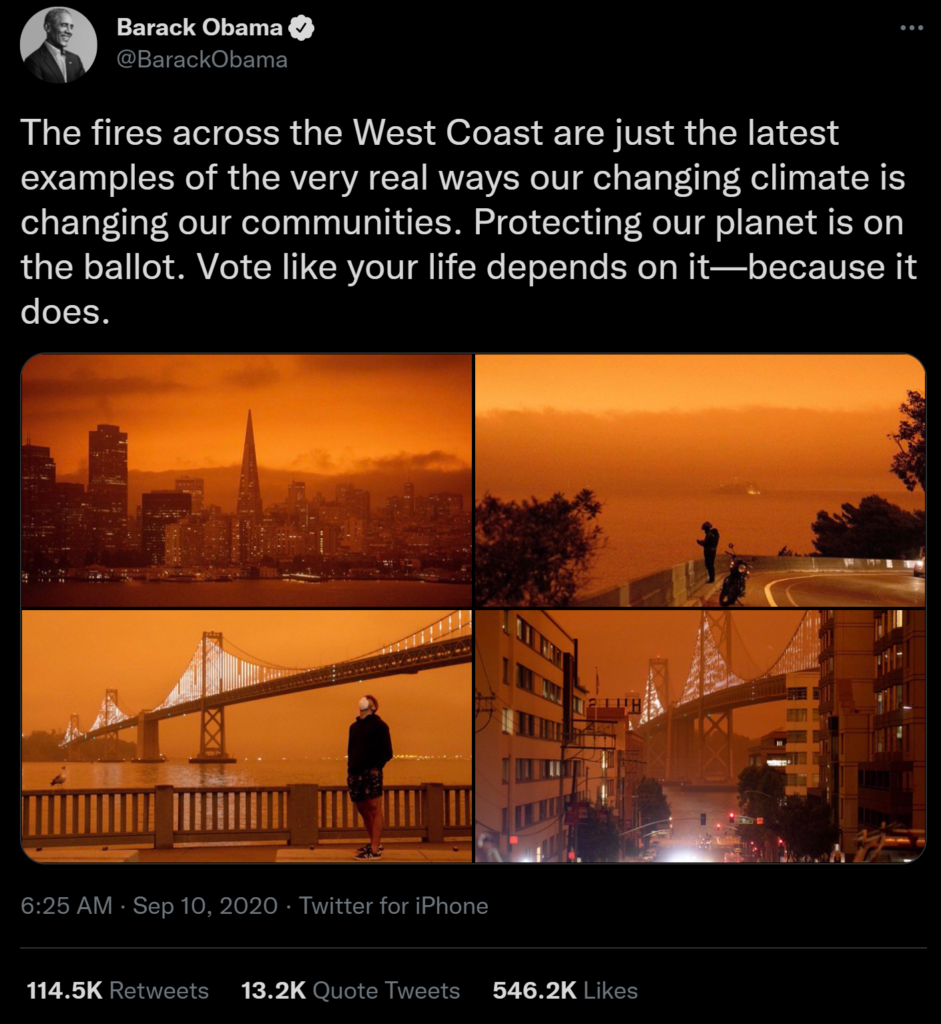
Effective propaganda has convinced the uninformed masses that Obama is a “cool guy” or some sort of a saint. He dropped thousands of bombs on Syria (even a hospital) and completely destroyed Libya, but I guess that’s okay because he’s “cool”.
And when the cool ex-President of the US is saying that forest fires are because of climate change, then for the uninformed masses, it automatically becomes the truth. Especially when other politicians repeat the same lie and the news is “trending” on social media with a lot of experts and celebrities talking about it. It also has 546,000+ likes. So many people “liked” the post, so it’s got to be true, right?
WRONG!
It was a lie because forest fires in the US have declined over the last 100 years.

And here’s what Adolf Hitler’s propagandist said about lies:

The ruling class uses or even creates “crisis” to scare people because when they’re scared, they’re easy to brainwash and more likely to give politicians more power or money. Climate change is one such crisis. And I have no doubt in my mind that they will blame climate change for the food shortage too.
If you want to protect your brain from the coming climate change propaganda (which will even lead to climate change lockdowns in the future), I suggest reading the work of Michael Shellenberger, Patrick Moore, and Bjorn Lomborg. Social media companies have been censoring their work because it doesn’t fit the narrative.
So What?
“So why the hell are you telling us all this, Ayush?”
Well, I’m not in the business of giving investment advice in India. So whatever I’m about to say is not investment advice. But I can tell you how we at The Logical Traders are planning to invest and trade our way through it.
Our first three trades of the year were Dwarikesh Sugar, Zuari Global and Madras Fertilizers and luckily, all three have performed nicely. Now we don’t claim to have a magic stock-picking wand that picks stocks like Dwarikesh but our core thesis is a food shortage and many of our trades will be based on it going forward.
Here’s where we will look to deploy our capital:
-
Farm Land & Agricultural Commodities
A shortage means food will only get expensive going forward. So it makes sense for us to buy a couple of months or even a year’s worth of non-perishable food supply in advance. This is the same as commodities trading; but instead of buying a contract, you’re just buying the physical. This is the safest and least risky way to play a food shortage in our opinion. Even in case our thesis is wrong, you can still eat the food that you store.Investing in a farm also makes sense to us. You can’t really put a price on the stability that comes with the ability to grow your own food.
-
Fertilizer Stocks
If there’s a shortage of fertilizer, the prices will only go up. And if the government is subsidizing fertilizer then the demand will also go up. Fertilizer companies should benefit from this scenario. So we have a bullish bias when it comes to these stocks and will be relying on technical analysis to trade in and out of the stocks we like.
-
Agriculture Stocks
Selective stocks in the agricultural sector should also benefit from this as well. Again, we plan on using technical analysis to move in and out of this opportunity. For instance, companies that make cotton can benefit.
-
Sugar, Rice & Other Food stocks
If there’s a global shortage for these products, then the prices of these products will also go up and exporting companies should benefit from this. Moreover, with the governments pushing for biofuels, the demand for sugar will only go up. Biofuel has essentially linked food prices to energy prices. So it will only make things worse.Same for companies that manufacture rice, tea, coffee etc. Of course, it doesn’t mean we’ll go ahead and buy them all. We’ll be selective with our picks and our timing.
If you’ve made it this far, I sincerely thank you for reading.
And to finish this piece off, I’d like to reiterate that none of this is investment advice and the analysis could go wrong. So please do your own due diligence before making any decision.
